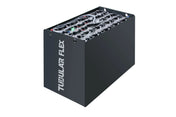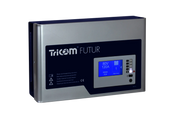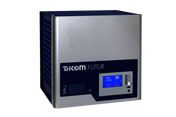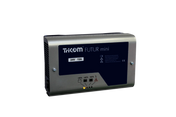Professional fire protection in loading areas is essential to protect employees, operations, and investments. When charging forklift batteries, risks arise from hydrogen gas, electrical defects, and thermal stress. Those who implement clear protection concepts minimize fire risks and comply with applicable standards and operator obligations .
Relevance and risks
Why is fire protection critical here?
When charging lead-acid traction batteries, hydrogen is produced, which is highly explosive even at very low concentrations. Defective chargers, damaged cables, or improper handling can also cause fires or explosions.
Explosion limits of hydrogen
Hydrogen is explosive in a range between 4 vol.% (lower explosion limit) and 75 vol.% (upper explosion limit) . The ventilation of loading areas must be designed so that the concentration remains well below 4 vol% even in the event of an accident.
Legal basis and standards
What regulations apply?
- DIN EN 62485-3: Safety of secondary batteries and battery systems – Requirements for traction batteries
- TRGS 722: Avoidance or limitation of dangerous explosive atmospheres
- Industrial Safety Ordinance (BetrSichV): Regular inspections of electrical systems and ventilation systems
- DGUV Regulation 68: Safety of industrial trucks
Operators are obliged to prepare a risk assessment in accordance with BetrSichV and TRGS 722, implement measures and document these.
Planning and construction of loading areas
Location, distances and separation
- Distance between battery openings and possible ignition sources: at least 0.5 m
- Distance to fire loads (e.g. packaging, wood, textiles): at least 1 m
- Distance to electrical systems, control cabinets or distributors: at least 2 m
Loading areas should be separate, dry, well-ventilated, and free of flammable materials. Clear floor markings and signage ("Loading area – access for trained personnel only") are mandatory.
Ventilation and gas extraction
Technical ventilation is essential to prevent the formation of explosive mixtures. A minimum air exchange rate of 5 h⁻¹ and an exhaust air duct at least 0.2 m below the ceiling is recommended, as hydrogen rises upwards.
Air flow in practice
Fresh air should be supplied at floor level, while exhaust air should be discharged at ceiling height. This ensures mixing and prevents local gas accumulation.
Technical safety
Chargers
Only use chargers approved for the battery type with temperature and overload monitoring. Chargers must be checked regularly in accordance with BetrSichV, particularly insulation resistance and temperature cut-off.
Electrical installations
Cables must be mechanically protected, laid without tension and protected against chafing. Loose cables, open connectors, or unprotected ends are not permitted. All electrical installations must be equipped with appropriate fuses and circuit breakers.
Fire protection technology
Suitable extinguishing agents
CO₂ and ABC powder extinguishers are suitable for electrical fires. CO₂ should be used with caution in small spaces, as it displaces oxygen.
Lithium-ion batteries
CO₂ and powder are unsuitable for lithium-ion batteries . Instead, use water mist or spray water extinguishing systems according to EN 14972 , which provide targeted cooling and prevent thermal bridges. In fleets with mixed battery types, the extinguishing technology should be differentiated accordingly.
Fire alarm and extinguishing systems
For larger loading zones, automatic fire alarm systems according to DIN 14675 are mandatory. Linear heat detection lines (LWZ) or multiple sensor detectors (smoke + heat) with redundant alarm are recommended. Automatic water mist or gas extinguishing systems can ensure rapid fire extinguishing and minimize subsequent damage.
Organization and instruction
Access, marking and order
Loading areas must be clearly marked and accessible only to authorized personnel. A tidy environment reduces fire loads and ensures safe escape and rescue routes.
Training and operating instructions
Employees must be regularly instructed in the safe handling of chargers , the recognition of faults and what to do in the event of a fire . Notices with brief instructions and emergency numbers must be clearly visible.
Tests and documentation
Recurring inspections
- Electrical systems and chargers according to BetrSichV at least annually
- Ventilation systems: Check air volume flow, filter condition and function
- Fire alarm and extinguishing systems: Visual and functional testing according to DIN 14675
Evidence management
All inspections, maintenance and training must be documented in writing. The certificates serve as proof to authorities, professional associations and insurance companies of the proper operation and effectiveness of the protective measures.
Practical check – most important measures at a glance
- Keep hydrogen concentration below 4 vol.% (explosion range 4–75 vol.%)
- Air exchange rate at least 5 h⁻¹, exhaust air duct under ceiling (≥ 0.2 m)
- Distances: 0.5 m to battery openings, 1 m to fire loads, 2 m to electrical systems
- Extinguishing technology: CO₂/powder (lead) – water mist EN 14972 (Li-ion)
- Fire detector: Linear heat or multiple sensor detector according to DIN 14675
- Document risk assessments, tests and instructions
HK Handels GmbH supports you in equipping safe charging areas – from chargers and cable systems to modern Li-ion batteries with integrated safety management.







